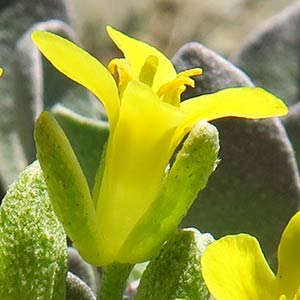|
alpine twin-pod, Washington bladder-pod, Washington twin-pod
|
silver twinpod, west silver bladderpod
|
| Perennials; caudex usually simple, rarely branched, (cespitose); (silvery) pubescent throughout, trichomes several-rayed, rays (1- or) 2-bifurcate, (low-umbonate, tubercles relatively few, small). |
Perennials; (diminutive); caudex simple or branched, (buried, with thatch of persistent leaf bases distally); (appearing silvery gray-green to silvery purple), densely pubescent, trichomes usually 5 or 6 (rarely 7)-rayed, rays bifurcate or incompletely so, (relatively short, stout, umbonate, moderately tuberculate to nearly smooth, lower layer smoother). |
several from base, decumbent to ascending, (unbranched), 0.5–1.5 dm. |
1–5 from base, prostrate to slightly decumbent, (arising laterally, also erect or ascending from tuft of basal leaves, unbranched, purple-green), 0.08–0.3 dm. |
(petiole slender); blade obovate, 3–5 cm (width 10–20 mm, base tapering abruptly to petiole), margins entire, (apex rarely slightly acute). |
(petiole slightly winged); blade oblanceolate, elliptic, or rhombic, (mostly flat, sometimes somewhat folded), 0.6–2.7 cm, (base tapering to petiole), margins entire, (apex rounded to rounded-acute). |
blade oblanceolate, 0.5–1.5 cm (width 3–5 mm), margins entire. |
(3–7, shortly petiolate or sessile); blade elliptic to oblanceolate, 0.3–0.5 cm, margins entire. |
subcorymbose. |
crowded, (ca. 3–7 fruits). |
sepals oblong, 8–10 mm; petals spatulate, 12–14 mm. |
sepals (greenish yellow), linear-triangular, 3.7–5 mm, (lateral pair subsaccate); petals oblanceolate to narrowly obovate, 4.5–9 mm. |
(divaricate, straight), 5–10 mm. |
(ascending, straight), 1.8–3.4 mm. |
didymous, mostly highly inflated (strongly flattened at least in 1/2 toward replum), 14–18 × 14–18 mm, (papery, basal sinus slightly notched, apical open, shallow); valves (retaining seeds after dehiscence), evenly pubescent; replum lanceolate, 7–10 mm, width 1.5–2.5 mm, as wide as or wider than fruit, apex acute to acuminate; ovules 8–10 per ovary; style 5–7 mm. |
(shortly stipitate, purple or greenish purple in age), slightly didymous, ovoid to obpyriform, 3–5 mm (wider than long, base rounded-obtuse, apex rounded, flattened, or slightly emarginate); valves (inflated, slightly wider than replum), pubescent, trichomes scattered; replum obovate to orbicular-obdeltate, apex rounded, obtuse, or truncate; septum complete or medially small-perforate; ovules 4–6(–8) per ovary; style 2–3.6 mm. |
flattened, (2–3 mm). |
relatively plump, (ovate to suborbicular, usually rounded on one side, ± flat or concave on the other, not mucilaginous when wetted). |
= 48–52, 52, 64, 67–70. |
|
|
|
|
|
| Flowering May–Jun. |
Flowering Jun-early Jul. |
| Alpine scree, rocky ridges, talus slopes, volcanic sands and gravel, serpentine gravel, granitic slopes, mountain shrub, subalpine fir, and whitebark pine communities |
Tundra areas with islands of Engelmann spruce on Leadville limestone, amidst limestone cobbles and gravel |
| (700-)1300-2400 m ((2300-)4300-7900 ft) |
3500-3700 m (11500-12100 ft) |
|
WA
|
CO |
|
Physaria scrotiformis is known only from La Plata County. (Discussion copyrighted by Flora of North America; reprinted with permission.) |
| FNA vol. 7, p. 624. |
FNA vol. 7, p. 662. |
| Brassicaceae > tribe Physarieae > Physaria |
Brassicaceae > tribe Physarieae > Physaria |
P. acutifolia, P. alpina, P. angustifolia, P. arctica, P. arenosa, P. argyraea, P. arizonica, P. aurea, P. bellii, P. brassicoides, P. calcicola, P. calderi, P. carinata, P. chambersii, P. cinerea, P. condensata, P. congesta, P. cordiformis, P. curvipes, P. densiflora, P. didymocarpa, P. dornii, P. douglasii, P. eburniflora, P. engelmannii, P. eriocarpa, P. fendleri, P. filiformis, P. floribunda, P. fremontii, P. garrettii, P. geyeri, P. globosa, P. gooddingii, P. gordonii, P. gracilis, P. grahamii, P. hemiphysaria, P. hitchcockii, P. humilis, P. integrifolia, P. intermedia, P. kingii, P. klausii, P. lata, P. lepidota, P. lesicii, P. lindheimeri, P. ludoviciana, P. macrocarpa, P. mcvaughiana, P. montana, P. multiceps, P. navajoensis, P. nelsonii, P. newberryi, P. obcordata, P. obdeltata, P. occidentalis, P. oregona, P. ovalifolia, P. pachyphylla, P. pallida, P. parviflora, P. parvula, P. pendula, P. pinetorum, P. prostrata, P. pruinosa, P. pulvinata, P. purpurea, P. pycnantha, P. rectipes, P. recurvata, P. reediana, P. rollinsii, P. saximontana, P. scrotiformis, P. sessilis, P. spatulata, P. subumbellata, P. tenella, P. thamnophila, P. tumulosa, P. valida, P. vicina, P. vitulifera |
P. acutifolia, P. alpestris, P. alpina, P. angustifolia, P. arctica, P. arenosa, P. argyraea, P. arizonica, P. aurea, P. bellii, P. brassicoides, P. calcicola, P. calderi, P. carinata, P. chambersii, P. cinerea, P. condensata, P. congesta, P. cordiformis, P. curvipes, P. densiflora, P. didymocarpa, P. dornii, P. douglasii, P. eburniflora, P. engelmannii, P. eriocarpa, P. fendleri, P. filiformis, P. floribunda, P. fremontii, P. garrettii, P. geyeri, P. globosa, P. gooddingii, P. gordonii, P. gracilis, P. grahamii, P. hemiphysaria, P. hitchcockii, P. humilis, P. integrifolia, P. intermedia, P. kingii, P. klausii, P. lata, P. lepidota, P. lesicii, P. lindheimeri, P. ludoviciana, P. macrocarpa, P. mcvaughiana, P. montana, P. multiceps, P. navajoensis, P. nelsonii, P. newberryi, P. obcordata, P. obdeltata, P. occidentalis, P. oregona, P. ovalifolia, P. pachyphylla, P. pallida, P. parviflora, P. parvula, P. pendula, P. pinetorum, P. prostrata, P. pruinosa, P. pulvinata, P. purpurea, P. pycnantha, P. rectipes, P. recurvata, P. reediana, P. rollinsii, P. saximontana, P. sessilis, P. spatulata, P. subumbellata, P. tenella, P. thamnophila, P. tumulosa, P. valida, P. vicina, P. vitulifera |
| Lesquerella alpestris |
|
| Suksdorf: W. Amer. Sci. 15: 58. (1906) |
O’Kane: Novon 17: 376, fig. 1. (2007) |
| |


